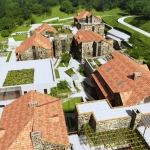Reveal the Secrets of Armenian “Dragon Stones” Welcome to one of the most attractive visitor centers in Armenia. Do you want to see the miracles of Armenian highlands with own eyes and uncover their centuries-old secrets? Then, it is high time to have a tour to Gegharkunik region. Armenian land as an integral part of ancient civilization and […]
Vishaps
Vishaps are ancient mythological beings which are represented in the form of high stone carved images, menghirs. Vishaps are extended in mythologies of the countries of Armenian upland and Forward Asia. Originally vishaps were deities or spirits of water and, possibly, have been connected with kuro-araksian archaeological culture. The people who occupied the Armenian uplands […]
Lori Fortress
Lori Fortress is one of the monuments of the Armenian Plateau well known for its historical-archeological value. It is situated near the city of Stepanavan. The necropolis and the dwelling occupy the territory of about 500 hectares. Lori Fortress survived more than one and a half thousand years, beginning from the last two centuries of […]
Dragon (vishap)
In the mythological beliefs of many people around the world water is closely connected with dragons. As the incarnation of chaos, dragons protected the newborn cosmic ocean and fought against the gods of sun, the bringer of harmony. The dragons (or demons) then came down to Earth from the cosmos and turned into the guardians […]
Zorakarer
Nowadays it is very difficult for us to definitely clarify when and for what reason several hundreds of vertical basalt obelisks of 3 metres high and more than 9 tones were erected. Situated in the environs of Sisian town in the province of Syunik, about 1800 metres above sea level, this monument reminds regular rows […]
Karmir Blur
Karmir Blur (Red Hill) is located in the south-western part of Yerevan, on the left bank of the River Hrazdan (the old name of the river is Ildaruni). About 3400 years ago on an upland named Kuarline a flourishing dwelling was founded, where people lived in little earthen buildings with several rooms. The hearth was […]
Carts and War-Chariots
The invention of the cart is one of the greatest achievements of mankind. It was a revolution in transportation, in the military sphere, and it promoted the development of civilization. The creation of the cart also had a long history. Different peoples of the ancient world independently participated in it. The archaeological excavations, rock carvings, ceramic statuettes […]
Copper
In Ancient Greece copper and bronze were called “khalkos” from the root “khalk.” According to linguists, this corresponds to “Hayk,” the name the Armenians gave to their country. The names “Hayos,” and “Ayas” that were given to copper by the Indians, Iranians, Germans and other Indo-European nations, are also connected with the name of the […]
Metsamor
Metsamor, one of the ancient monuments of the Armenian Plateau, is situated in the enter of the Ararat Valley, 30 kilometres west of Yerevan, not far from the spring of the River Metsamor. Excavations confirm that people settled in this valley with abundant water sources, hunting grounds and pastures seven thousand years ago. The Metsamor Castle was founded on a […]
Sun Dials
By watching the course and disposition of the luminary in the firmament even the Stone Age man determined the hours of the day. Shadows cast by natural stone obelisks and the protruding erected bodies played significant role. Studying the semicircular path of a shadow from sunrise to sunset and dividing it into equal parts man took the […]









